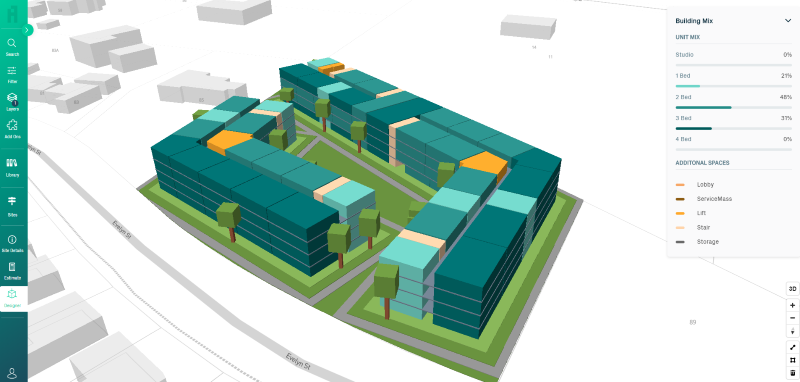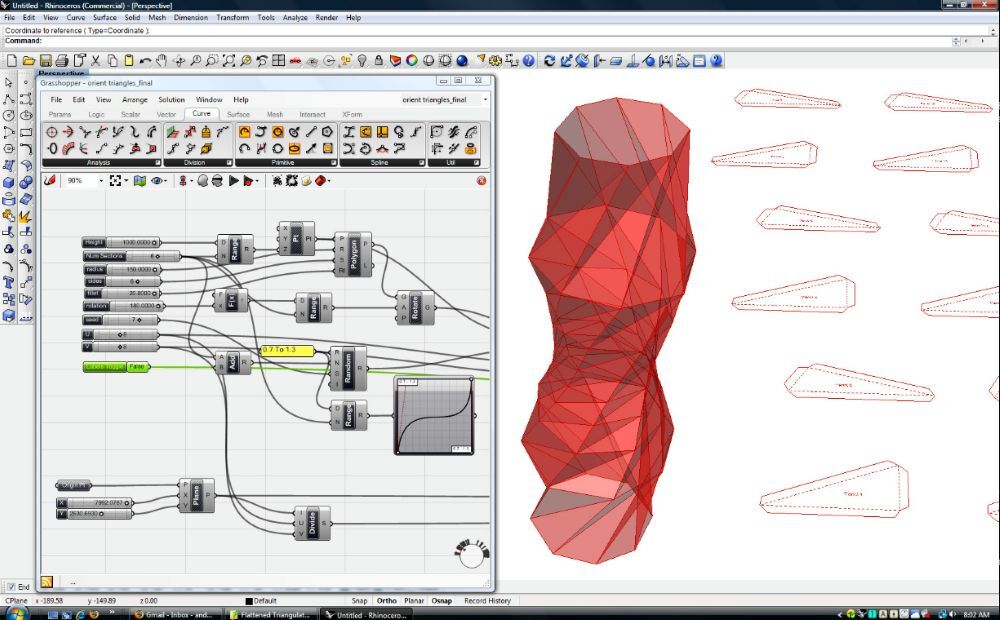
In parametric design, achieving high accuracy while keeping design flexibility is a constant challenge. The Snapping Gecko in Grasshopper plugin bridges this gap, allowing designers to manage geometry interactions with greater control. Its precision-based workflow enhances modeling accuracy across complex forms, making it a valuable component for architects and computational designers aiming for efficiency and detail-driven results.
With the growing use of Snapping Gecko plugin in architecture, professionals are exploring faster modeling techniques that maintain precision across large-scale projects. In India, employees who know Grasshopper earn an average of ₹17.1 lakhs, reflecting the strong value of this skill in design practices.
What is Snapping Gecko?
Snapping Gecko is a Grasshopper plugin designed to enhance how designers handle precision alignment within parametric models. It simplifies spatial coordination by allowing elements to align accurately while maintaining flexibility in design adjustments. Through grasshopper geometry control, it ensures clean connections between complex geometries, helping architects and designers create well-structured, accurate digital models without disrupting their creative flow.
Key features of Snapping Gecko that enhance modeling accuracy:
- Supports real-time interaction, letting users adjust objects without losing reference accuracy.
- Allows intuitive snapping in Grasshopper to align geometry components with precision and control.
- Offers clean control over connection points, improving modeling efficiency in complex projects.
- Reduces manual corrections by maintaining consistency across geometric relationships.
- Enhances collaboration by making parametric definitions clearer and more structured.
- Integrates smoothly into existing workflows, ensuring precision without extra complexity.
Installing and Setting Up Snapping Gecko

Setting up Snapping Gecko is a simple process that ensures seamless integration within Grasshopper. It should be installed carefully to maintain stability and consistent performance. Following the correct setup steps helps designers begin using its accuracy-focused tools smoothly, without configuration errors or workflow interruptions.
1. Download the Plugin Package
Begin by visiting the official Food4Rhino or developer page to download the latest version of Snapping Gecko. Ensure that the downloaded file matches your Rhino and Grasshopper versions to prevent compatibility issues during installation. Always save the file in an easily accessible location before proceeding.
2. Extract and Install the Plugin
Once downloaded, unzip the plugin folder. Open Grasshopper in Rhino, then go to the “File” menu and select “Special Folders” → “Components Folder.” Copy the extracted Snapping Gecko files into this folder. Restart Rhino and Grasshopper to allow the system to recognize the new plugin.
3. Verify Successful Installation
After restarting, open Grasshopper and look for the Snapping Gecko tab or icon within the interface. If visible, it indicates a successful installation. If it doesn’t appear, double-check that all files were copied correctly and the plugin version is compatible with your software setup.
4. Configure Initial Settings
Once the plugin loads, navigate to its settings panel within Grasshopper. Adjust preferences such as snapping tolerance, visual indicators, or workspace visibility. This helps Snapping Gecko integrate smoothly with other tools available through the Grasshopper precision plugin setup, ensuring consistency with your workflow and modeling requirements.
5. Test the Plugin Functionality
Create a simple model to test snapping behavior and alignment precision. Try connecting different geometries to confirm that the plugin responds correctly. If the snapping indicators and alignment responses work smoothly, the setup process is complete, and Snapping Gecko is ready for project use.
Top Use Cases of Snapping Gecko in Architecture
Snapping Gecko plays an important role in architecture. As an architectural modeling plugin, it supports smoother workflows and helps maintain organized parametric structures, making it a practical tool for a variety of architectural projects.
Here are some of the top use cases of Snapping Gecko in architecture:
- Facade Pattern Coordination: Maintains consistent alignment between facade panels, joints, and frames, ensuring visual order and dimensional accuracy in exterior systems.
- Structural Node Placement: Helps align and position connection points between beams or trusses, improving accuracy in complex support frameworks.
- Parametric Furniture or Interior Elements: Assists in aligning custom interior components like partitions, fixtures, or modular furniture that rely on geometric precision.
- Site Layout Alignment: Ensures accurate placement of buildings, pathways, and landscape features within a defined site grid or reference system.
- Digital Fabrication Preparation: Prepares precise geometry alignment before exporting models for CNC cutting, 3D printing, or panel fabrication workflows.
- Complex Roof or Canopy Design: Supports the accurate positioning and connection of freeform roof panels, enabling smooth assembly of intricate canopy structures.
Using Snapping Gecko With Other Grasshopper Plugins

Using Snapping Gecko alongside other Grasshopper plugins can improve workflow efficiency and coordination in complex projects.It lets designers control model alignment while integrating smoothly with various parametric tools.
- Integration with Kangaroo: Maintains precise alignment while using Kangaroo’s physics simulations for structural form-finding and dynamic modeling.
- Coordination with Weaverbird: Preserves Snapping Gecko alignment when performing mesh subdivision, smoothing, and topological operations.
- Compatibility with LunchBox: Supports paneling and pattern generation workflows without disrupting snapping relationships in parametric models.
- Connection with Human UI: Lets users manipulate snapped components interactively through custom Grasshopper interfaces for better design control.
- Collaboration with Ladybug Tools: Keeps geometric relationships consistent while incorporating environmental analysis and simulation data into parametric models.
How To Master Snapping Gecko?
You can learn to use Snapping Gecko effectively through the Master Computational Design Course offered by Novatr. This course provides practical guidance on integrating parametric tools in Grasshopper, exploring precision modeling, and understanding advanced workflows. It is designed to help designers and architects gain hands-on experience in controlling geometry and managing complex parametric projects.
Here’s what the course offers to enhance your skills:
- Five powerful industry tools: Grasshopper, Rhino 3D, Flux.ai, ComfyUI, and D5 Render.
- Master popular plugins like Paneling Tools, DeCoding Spaces, Anemone, Galapagos, Wallacei, LunchBox, Open nest, and Horster Animation to create smarter and faster design workflows.
- Understand how to build parametric and generative design workflows used by top global firms.
- Learn how to automate repetitive design tasks, explore AI-driven creativity, and produce high-quality renders for presentations.
- Develop a professional computational design portfolio showcasing your project-based learning.
- Earn dual certification from Novatr and NSDC (National Skill Development Corporation) upon completion and step confidently into the world of future-ready architecture and design.
Disclaimer – Course details, including curriculum, duration, fees, and related information, are for informational purposes only and may change at the company’s discretion without prior notice. Please visit the official course page or contact the admissions team for the latest updates.
Conclusion
Snapping Gecko in Grasshopper helps designers manage complex parametric models with accuracy and control. It improves element alignment, reduces manual adjustments, and streamlines workflows by connecting geometry management with precision, helping architects maintain organized digital models without losing design flexibility or consistency.
For designers seeking to expand their skills, the Master Computational Design Course offered by Novatr provides hands-on learning in parametric tools, precision modeling, and workflow strategies. Visit our resource page to explore the course and gain practical guidance for effectively using advanced Grasshopper plugins in architectural and computational design projects.
Frequently Asked Questions:
1. What is Snapping Gecko in Grasshopper?
Snapping Gecko is a Grasshopper plugin that helps designers achieve precise alignment and better control over complex parametric models.
2. How is the use of Snapping Gecko plugin in architecture applied?
It is used to maintain geometry, organize parametric structures, and streamline modeling workflows for architectural projects.
3. Can Snapping Gecko work with other Grasshopper plugins?
Yes, it integrates smoothly with various parametric modeling tools, enhancing alignment, and workflow in combined plugin setups.
Was this content helpful to you



.jpg)




